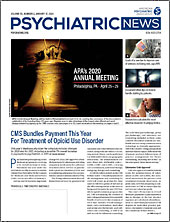For many psychiatrists, the realization that something is amiss develops slowly. First, patients start calling a few times a week, then they’re knocking on the office door on a regular basis. Soon, they start dropping off gifts. And suddenly, they’re at the psychiatrist’s home.
The term “stalking” generally refers to repeated, unwanted, and distressing behaviors. For many physicians, recognizing and knowing what to do when they are being stalked by their patient can be difficult, and many are unsure where to turn for guidance.
APA’s Council on Psychiatry and Law has developed a resource document on stalking, intrusive behaviors, and related phenomena by patients. The document provides direction on what to do should stalking occur, how psychiatrists can ensure their own safety, ways to prevent such situations, and legal and ethical issues to consider.
“It is clear that many physicians will struggle with embarrassment and anxiety [when being stalked by a patient] for some time before they seek guidance,” said Maya Prabhu, M.D., LL.B., an associate professor of psychiatry at Yale School of Medicine and corresponding member of APA’s Council on Psychiatry and Law. “They are concerned about being ‘blamed’ for the behaviors.”
Prabhu co-chaired the work group that crafted the document along with Debra Pinals, M.D., a professor of psychiatry at the University of Michigan and chair of APA’s Council on Psychiatry and Law. Additional authors of the resource document include Pratik Bahekar, M.D., Jessica Bayner, M.D., Elissa Benedek, M.D., Renée Binder, M.D., Allison Brandt, M.D., Michael Champion, M.D., Vivek Datta, M.D., Elizabeth Ford, M.D., Richard Frierson, M.D., Lisa Harding, M.D., Abhishek Jain, M.D., Louis Kraus, M.D., Bhinna Park, M.D., Megan Pruette, M.D., Tina Thomas, M.D., and Howard Zonana, M.D.
Stalking emerged as a topic of concern, Prabhu explained, during a larger conversation about violence against physicians by patients. “Some of the residents and fellows on the council, in particular, had mentioned assaults by patients, even some homicides, in recent years, and resident anxieties about how to handle escalating situations,” she continued. “Workplace violence is an important but large topic, and we decided to focus on stalking and intrusive behaviors.”
Few studies have taken a hard look at instances of stalking within psychiatry. Often, surveys of physicians find that psychiatrists are one of the most likely specialists to experience stalking. A June 2013 study in the Journal of the American Academy of Psychiatry and the Law surveyed 2,585 United Kingdom psychiatrists and found a 21.3% lifetime prevalence of having been stalked.
“Our work is about relationships,” Pinals said. Patients might exhibit behaviors related to being attached to their psychiatrists that may be completely appropriate, she said. Determining where to draw the line between acceptable and inappropriate behaviors, however, is sometimes difficult.
So, too, is simply defining stalking. While the Violence Against Women Act of 2005 defines the phenomenon as “engaging in a course of conduct” that would cause a “reasonable person” to fear for his or her safety or cause “substantial emotional stress,” definitions vary among states. One of the challenges of comparing studies about stalking within psychiatry, Prabhu noted, is that there is no single definition.
Pinals recommended that psychiatrists consult with others about what they’re experiencing, especially if a situation feels beyond their capacity to manage. “It’s hard to deliver care when you’re in fear,” she said.
The resource document also stresses the importance of prioritizing one’s safety, and consulting with law enforcement, hospital security, legal counsel, and forensic psychiatric experts when being stalked by a patient.
“Depending on the setting, a hospital or university may have a threat management team or a forensic psychiatry service … that can be particularly useful in scenarios that take place in an institutional context,” according to the resource document. “In a private setting, psychiatrists may consider contacting the nearest university’s forensic psychiatry program, professional organizations like the Association of Threat Assessment Professionals (ATAP), or local law enforcement that has specialized services.”
Consultation is especially important because each incident of stalking is unique, as are the laws and policies governing them, which depend on the jurisdiction in which the stalking occurs, the resource document explains.
Solutions must be carefully crafted with the person who is being stalked, Pinals said, while also considering the needs of the patients.
“Some patients may be better managed in certain settings than others—for example, a mental health clinic with multiple team members rather than in a private practice,” Prabhu said. The resource document provides ideas on how to transition care if necessary.
Additionally, the resource document specifically addresses how residents and their supervisors should handle stalking. “Students and residents are especially concerned about reporting scenarios for fear that their standing in their training programs will be jeopardized,” Prabhu said.
She added that she encourages her residents to seek input from others. “Never worry alone,” she said. ■
“Resource Document on Stalking, Intrusive Behaviors and Related Phenomena by Patients” is posted
here. “Psychiatrists’ Experiences of Being Stalked: A Qualitative Analysis” is posted
here.



